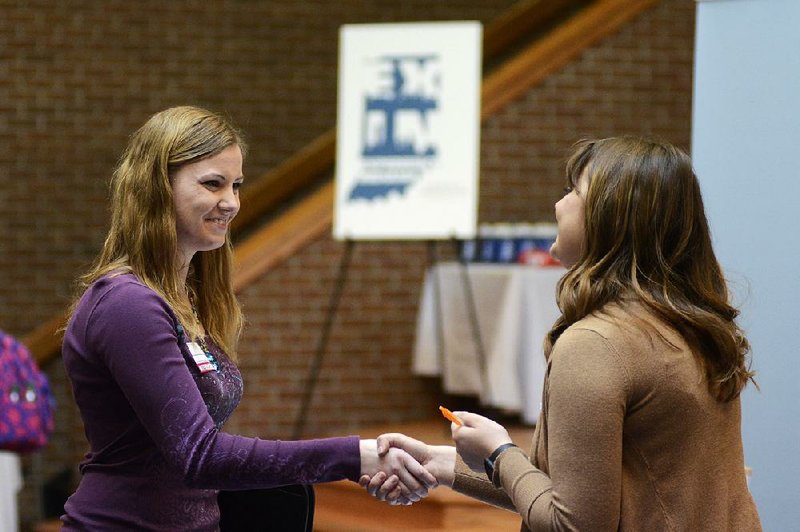U.S. hiring cooled in March after a strong February while wages picked up slightly, returning labor-market progress to a more sustainable pace that keeps the Federal Reserve on track for further interest-rate increases.
Payrolls rose by 103,000 workers, Labor Department figures showed Friday. The jobless rate was 4.1 percent for a sixth month, bucking forecasts for a decline, while average hourly earnings increased by 8 cents and are up 2.7 percent over the past year, matching projections.
The results follow strong hiring in 2017 and show an average pace of payroll growth this year that's still sufficient to push down the unemployment rate, which remains the lowest since 2000 and below Federal Reserve estimates of levels sustainable in the long run. A pickup in wages -- which has remained elusive in this expansion -- would support consumer spending, though some economists worry it may also spark inflation.
"This is some payback for strong job growth in February," said Ryan Sweet, an economist at Moody's Analytics Inc. in West Chester, Pa. Weather had some influence so "there's no reason to be depressed" about the low March payrolls number, and the overall picture is "pretty much steady as she goes."
Robert Frick, corporate economist at the Navy Federal Credit Union, said the numbers reflect a healthy long-term trend -- companies have hired an average of 200,000 workers each month this year -- but flat wages concern him as the country hits 90 straight months of employment gains.
"In previous expansions, wages were growing by 4 percent annualized," he said. "We're in pay-cut territory right now."
The payroll-gains figures reflected reversals in construction and retail. Construction payrolls fell by 15,000 in March, the first decline since July, following a gain of 65,000 in February. Retailers cut 4,400 workers, after a rise of 47,300 in February.
The weather may have played a role, economists said before the report. Snowstorms in the Northeast probably restricted hours worked and kept people away from their jobs, and March may also have seen some payback after warmer weather boosted employment in February.
While the average workweek for all private employees was unchanged at 34.5 hours in March, hours edged down for production and nonsupervisory workers, as well as those in manufacturing. A shorter workweek has the effect of boosting average hourly pay.
The participation rate, or share of working-age people in the labor force, decreased to 62.9 percent after jumping 0.3 percentage point to 63 percent in the previous month. The rate, still hovering near the lowest level since the 1970s, will continue facing downward pressure as older workers retire. At the same time, improving job prospects are helping attract many people from the sidelines.
Even with the smaller payroll gain, the report is largely in sync with the view of Fed policymakers that the labor market is tight. They see the unemployment rate reaching 3.6 percent at the end of next year.
The strength in manufacturing employment, which has posted the best 12-month streak since 1998, bodes well for a turnaround in service-sector hiring in the near term. Similarly, the construction soft patch is likely to be short-lived. As such, Bloomberg Economics is not changing its overall assessment of the labor market. Accelerating economic growth in an environment of mostly stable wage pressures should result in continued modest acceleration in the pace of hiring through at least midyear.
Economists estimate that monthly payroll gains even below 100,000 will be sufficient to keep pushing down the unemployment rate, which is derived from a separate Labor Department survey of households.
Revisions to previous reports subtracted 50,000 jobs from payrolls in the previous two months, according to the figures.
The solid run of hiring and bigger after-tax paychecks will help sustain growth in consumer spending, which is nonetheless projected to cool in the first quarter after the strongest quarter in three years.
Average hourly earnings rose 0.3 percent from the previous month after a 0.1 percent gain, in line with economists' estimates, the report showed. The advance in the 12 months through March followed a 2.6 percent rise in the year through February. A separate measure, average hourly earnings for production and nonsupervisory workers, increased 2.4 percent from a year earlier.
Worker pay probably also benefited as the 15th of the month, a payday for many people, fell within the government's survey week that includes the 12th.
Employers continue to hire to meet demand, and remain reluctant to let go of existing employees during a shortage of qualified workers. Weekly unemployment claims are hovering near the lowest level since 1973.
The breakdown of data across industries showed manufacturing added 22,000 jobs. That's consistent with other reports showing strength in factory activity. Service providers increased payrolls by 87,000 workers.
Information for this article was contributed by Chris Middleton, Sophie Caronello and Benjamin Purvis of Bloomberg News; by Ben Casselman of The New York Times; and by Danielle Paquette of The Washington Post.
RELATED ARTICLES
http://www.arkansas…">Trump adds to fiery talk of trade war http://www.arkansas…">Tariff threats zap stocks
Business on 04/07/2018
